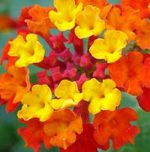 Lantana camara is a perennial evergreen shrub native to tropical Central and South America but has been planted as an ornamental for its very attractive flowers. It spread to Europe, Asia, Africa, Australia, New Zealand, and Oceania and has naturalized and become invasive in frost free areas of the world including southern Florida, the Gulf Coast and southern California. It can form dense thickets, is toxic to livestock, and produces toxins that inhibit the growth of nearby plants. With its tolerance of very variable growing conditions and extremely high reproductive capacity by seed, this plant is a threat to agriculture as well as biodiversity. USDA Hardiness zones 10-11
Lantana camara is a perennial evergreen shrub native to tropical Central and South America but has been planted as an ornamental for its very attractive flowers. It spread to Europe, Asia, Africa, Australia, New Zealand, and Oceania and has naturalized and become invasive in frost free areas of the world including southern Florida, the Gulf Coast and southern California. It can form dense thickets, is toxic to livestock, and produces toxins that inhibit the growth of nearby plants. With its tolerance of very variable growing conditions and extremely high reproductive capacity by seed, this plant is a threat to agriculture as well as biodiversity. USDA Hardiness zones 10-11
The following natives are recommended as alternatives:
Marlberry (Ardisia escallonioides)
Marlberry is a mounded shrub or small tree growing ten to fifteen feet tall and having terminal panicles of small white flowers, glossy, deep green leaves, five to six inches long, and dark purple berries. It is native to pinelands, marl rides, and hummocks in central and southern Florida. USDA Hardiness Zones 9-11
Coral Bean (Erythrina herbacea)
A native of low woods, savannas, and swamp and pond margins from North Carolina south to Florida and west to Texas, this deciduous shrub or small tree grows five to ten feet tall, has compound leaves with three broad, long, leaflets with pinched tips, and produces plumes of bright scarlet three inch long flowers beginning in mid- to late summer. USDA Hardiness Zones 7-10
Golden Creeper (Ernodea littoralis)
Golden creeper is an evergreen prostrate ground cover one to three feet tall found on Florida beaches but is also native to the Caribbean, Central America and northern South America. It has small light green succulent leaves, inconspicuous pink tubular flowers, and golden berries. USDA Hardiness Zones 10-11
Lantana (Lantana involucrata)
A medium sized shrub four to eight feet tall, this lantana is native to central and southern Florida where it grows on hammock edges, pine rocklands, and coastal thickets. It has white to pink flowers that are semi-showy but provide nectar for many butterflies. Plants are tolerant of drought and high salty winds so are good for hurricane prone areas. USDA Hardiness Zones 9-11
Scarlet Sage (Salvia coccinea)
This herbaceous perennial grows three to four feet tall and has spikes of showy red flowers that provide nectar to hummingbirds, bees, and other insects. It is native to South Carolina south to Florida and west to Texas but is suitable for areas in Arizona, New Mexico, Nevada, California, Oregon and Washington.USDA Hardiness Zones 4-10